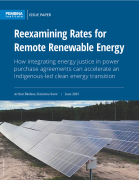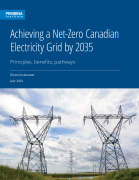The Pembina Institute is pleased to have had the opportunity to provide insights into how a Clean Electricity Standard can deliver a credible net-zero grid in Canada, that results in significant emissions reductions and that near-zero emissions from electricity generation by 2035. The content of our submission reflects the Institute’s most recent understanding and research on the topic. We will continue to publish and submit further comments through the policy development process as further research is conducted and additional modelling results are available.
What is the Clean Electricity Standard?
The Clean Electricity Standard (CES) is the key regulatory instrument that the federal government is proposing to achieve a net-zero emissions electricity system by 2035. It is being developed alongside other crucial measures, including industrial carbon pricing and several supportive investments and programs. In this way, the CES forms part of an overall policy suite.
The CES will be a regulatory standard applicable to emitting electricity generators, implemented under the Canadian Environmental Protection Act (CEPA). If designed properly, it can be the cornerstone policy tool that sends a clear investment signal against unabated emitting electricity generation in Canada. An effectively designed CES will achieve the following outcomes:
- Send an immediate signal that prevents investment in emitting electricity generation assets and encourages investment in zero- or negative-emissions electricity.
- Generate early and deep reductions of GHGs, rather than relying on greater reductions closer to 2035.
- Secure cost-effective GHG reductions.
- Protect and enable energy affordability and access to electricity.
- Deliver a credible net-zero grid by 2035 that is nearly non-emitting and for which any residual emissions are fully offset, with credible offsets from emissions-negative activities.
What does a net-zero grid mean?
A net-zero grid means having non- or near zero-emitting electricity generation supply, with any remaining emissions fully offset. A net-zero grid should be primarily supplied by cost-effective non-emitting technologies including renewables, storage, transmission interties, and demand flexibility. Currently, Canada is set to see significant growth in natural gas-fired generation to replace the retiring coal capacity and to meet increasing demand. For a grid that is viewed as credibly net-zero by Canada’s international peers, investors, and companies with ESG goals, it cannot include unabated natural gas generation beyond truly emergency applications. Moreover, any remaining emissions from the balance of carbon emissions that are not captured or from emergency unabated fossil fuel use must be fully offset by credible, verifiable greenhouse gas removals.
Why is a net-zero grid necessary?
Achieving a net-zero electricity grid by 2035 will provide both climate and economic benefits for Canada. A clean grid is an essential element of the government’s intention to achieve 40-45% emissions reductions from 2005 levels by 2030, and a net-zero economy by 2050 (as outlined in Canada’s 2030 Emissions Reduction Plan). A clean grid will also be essential for other sectors (e.g., buildings, transportation, heavy industry) to achieve net-zero through electrification, substituting the use of fossil fuels with clean electricity. Electrification is expected to offer the most cost-effective option for decarbonizing these sectors, but that option is underpinned by a clean electricity supply.
Canada is not alone in this endeavour. The International Energy Agency has determined that all developed countries must achieve a net-zero grid by 2035 to keep global temperature rise to under 1.5°C. Countries like the U.S., the U.K. and Germany have also committed to a net-zero or clean grid by 2035. In fact, the U.K. grid operator is on track to be able to operate the grid with zero-carbon energy by 2025.









